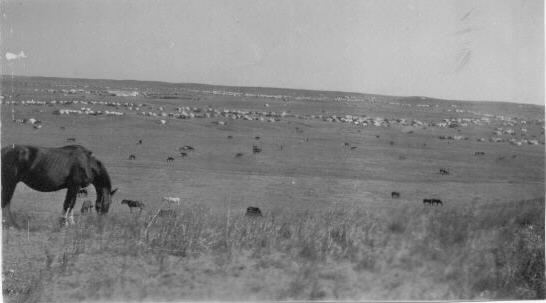

| Campsites at the Sun Dance |
 |
|
An Indian farmer with his two daughters drove up in a
dilapidated Ford. He had some business with the agent, and while absent
on that duty the young ladies were interrogated about the big show
where it was located and how to get there. For seventy-five cents they
would take us to the grounds three miles away. The bargain was closed;
down the steep bank, around the curves and up the cliffs on the
opposite side of the "river" the rickety car was sent through deep
dust, for a first glimpse of the big camp. From a promontory was witnessed a scene the like of which was never seen before and in all likelihood will not be seen again. Far to the west, beyond the Bad Lands, were the Black Hills, and to the east the lower hills hid the vast plains that roll away to the Missouri. An equal distance north and south once formed a buffalo range where countless herds fed and furnished food, clothing and shelter for the red race, since the coming of the Spanish with horses, at the south. In a great saucer-like area between the hills were assembled the largest Indian Congress of modern times. They told us that when all had arrived there would be twenty thousand Indians in camp. A thousand or more tepees and tents were scattered about in villages of dozens, fifties and hundreds, over this undulating, parched and dusty three-by-five-mile camping area. All around within the range of vision were the horses and ponies in bands large and small pasturing on the sun-dried grass; they were herded by the youths mounted in cow-boy style on their duns and pintos, who kept them constantly rounded up to prevent their too widely straying. Droves of the ponies were being constantly driven to and from the watering place two miles away, where the little river wound its way among the scrubby plum and cottonwood trees below the post-trader's log store. Everywhere in the open spaces were Indians, old and young; women with papooses on their backs, and dogs, dogs of all sizes and all breeds and colors—they were a part of every family. it was like a white man's country fair; they were having their annual visit before the ceremonies began; coming, going, singly and in crowds or sitting in circles squat on the ground, chatting in their peculiar dialect and sign-language, of neighborhood affairs and idle gossip. Women, girls and children were dressed in gorgeous colors; some in white buckskin robes with fancy beadwork; others in brilliant shade of synthetic silk or sateen, and still others in green or red-striped shawls artfully draped about the shoulders. Mostly they were bespangled with gay and sparkling jewelry and strings of beads about the neck and arms. Old-time warriors, bedecked with eagle feathers, fancy moccasins and war-dance regalia, strode about in all their former glory, while here and there an old chief, in scalp-shirt, with the lordly war-bonnet of black-tipped eagle quills reaching to his heels, could be seen in all his stately bearing. It was a thrilling spectacle and brought back memories of frontier times of half a century ago. Artist could not paint, nor is it possible to write, a true description of it or of the tremendous magnitude and meaning of it all. The open-air stage with its human and animal players stretched away as far as the eye could see. Here were gathered many tribes and clans, the relic of a great race, once possessors of a vast continent—remnant of a race robbed of its God-given heritage—assembled here for the last time to pay homage to their Great Spirit, a ceremony denied to them for forty-five years by their merciless conquerors. Now, with the omission of the self-inflicted tortures, they were to have the right to pay reverence to their God, the sun—symbol of their Supreme Power, source of light, of heat and of all else that lives and has its being on the earth. Only the old men and women knew and understood the intricacies of the ritual—the others were the product, or shall we say victims, of the white man's civilization. |
|
|
|
|
|
|
||
| previous page | table of contents | next page |
|
|
||